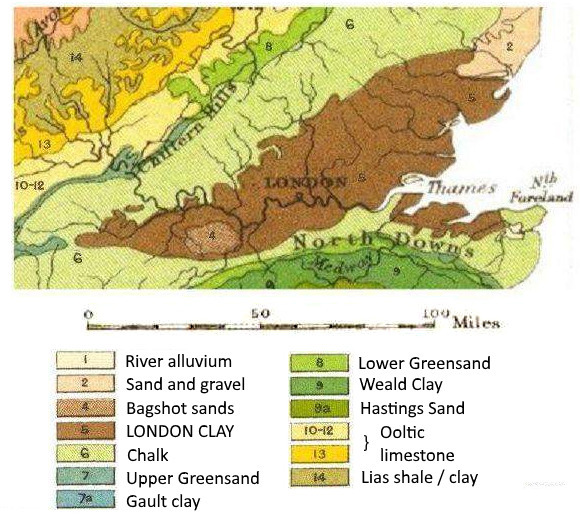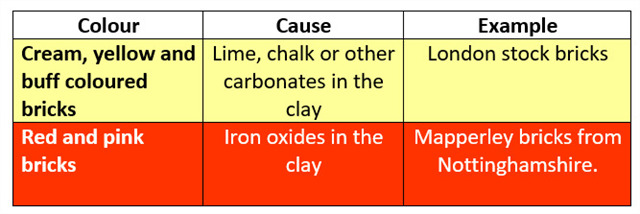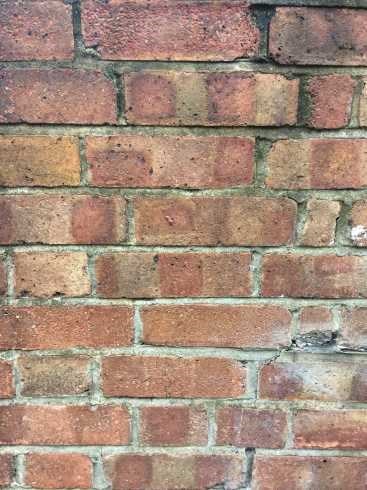This EarthCache is located in an area frequently patrolled by Police. Please avoid acting suspiciously whilst completing the Tasks, and if challenged, please explain about geocaching. You could also point out that there is no hidden physical box, but that you are simply studying the bricks visible to everyone.
Many EarthCaches in London focus on exotic stones used to build fine buildings, carve sculptures and pave the streets. This stone had to be imported to London, because the capital is short of sources of building stone. The Tower of London is partly built from Kentish ragstone, a type of limestone from distant Maidstone in Kent. Medieval buildings were constructed from wood, clay (wattle & daub between timber supports) and thatch. Thatched roofs were banned in London in 1212 following a fire estimated to have killed 3000 people. After the Great Fire of London in 1666 the Rebuilding Act of 1667 proclaimed that ‘all the outsides of all Buildings in and about the said Citty be henceforth made of Bricke or Stone’.
Faced with a ban on thatch and external timber, it is no surprise that London’s builders turned to local clay as a building material to make bricks and roof tiles.

The geology map of London and the Southeast, above, shows that London has few sources of hard building stone close by. It has ample sources of clay, especially the London Clay (dark brown on the map).
Geology lesson: the formation of clay
Clay is a sedimentary material. Clays that have formed more recently have a high water content and are plastic (deformable). If compressed by burial clay becomes drier, harder and more brittle and rock-like over time – eventually becoming hard ‘mud-stone’.
- The minerals that make up clay are hydrous aluminium phyllosilicates such as kaolinite, smectite and illite.
- They are formed from the chemical weathering of other rocks. Minerals such as feldspar and mica that are found in igneous, metamorphic and sedimentary rocks are broken down by chemical weathering processes like hydrolysis and this forms clay minerals.
- Clay particles are tiny: they are 1-4 micrometres in size (0.001 – 0.004 mm).
- Most clay deposits form when the tiny clay particles settle out of calm water (such as in a lake, river or on the sea bed).
- The London Clay formed on the bed of a shallow sea about 50 million years ago.
Geology lesson: weathering
Like all building materials, bricks are at risk from weathering. Weathering is the in-situ break-down of material by chemical, mechanical or biological agents. Chemicals, such as acids can attack the surface and cause chemical changes - even dissolving some materials. High pollution levels can increase chemical weathering. Mechanical weathering can be caused by changes in temperature, especially when water freezes in holes or cracks, expands as ice crystals grow and this causes cracking (freeze-thaw, or frost action, weathering). Biological weathering can be caused by chemicals released from algae or other plants, or even plants roots forcing cracks open. In brickwork, weathering can produce cracks, a powdery loose surface, flaking and spalling.
Brick making
Bricks are made from a mixture of clay, sand and other materials such as lime. Bricks can be made by hand in wooden moulds, pressed or extruded. Most are rectangular. A UK house brick is usually 215 × 102.5 × 65 mm in size. The clay bricks are fired in a kiln at a temperature of 800-1100°C and undergo a process of vitrification which produces the hard, durable final product.
The colour of bricks depends on:
- Kiln firing temperature, as colour changes take place as temperature increases.
- The type of clay used, and any additions to the clay mix.
London stock bricks often had ash or cinders mixed into the clay; this burned off during firing in a kiln leaving holes or pore spaces.
Two common colours of bricks used in London are:

Bricks are a durable, cheap, versatile building material. Today, they come in a huge range of colours, shapes and styles. However, like any building material they deteriorate over time due to the effects of chemical and mechanical weathering.

Brickwork - but not the bricks of St Pancras or Kings Cross!
Kings Cross and St Pancras Stations
Kings Cross Station opened in 1852 as the London terminus of the Great Northern Railway. Its main façade is built of brick and has two great arches between the central clock tower. Kings Cross was extended and extensively renovated in 2012.
St Pancras Station opened in 1868 as the London terminus of the Midland Railway. It became the Eurostar terminal in 2007 after the entire station was extensively renovated.
Questions
Please carefully examine the bricks used for the façade of both stations. Use the information in the description above, and your observations at the two waypoints, to answer the questions below.
Question 1:
Compare the bricks used for Kings Cross and St Pancras stations in terms of:
a) Their different colours
b) Size: measure at brick at each location (height and width), are they the same or different size
c) Surface texture: describe the surface of each brick, are they uniform or irregular? Which station has bricks which more imperfections?
d) One of the bricks is more porous (it has more holes in it) than the other. Which station has the more porous brick?
Question 2:
Having examined the bricks of both St Pancras and Kings Cross, which station was built with bricks using local clay?
Question 3:
Which brickwork, St Pancras or Kings Cross, has greater evidence of weathering of the bricks? Describe the weathering and suggest what might have caused it.
Question 4:
While not compulsory, we would appreciate any photographs of you and / or your GPS with the humble bricks!
There is no need to enter either station (although both are impressive), simply examine the bricks of the external walls.
Please use the Message Centre, or email, to send us your answers. You may log your find immediately but logs that are not accompanied by answers within a reasonable time will be deleted.